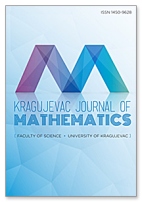AJ-Statistical Approximation of Continuous Functions by Sequence of Convolution Operators
 Download PDF
Download PDF
Authors: S. DUTTA AND R. GHOSH
DOI: 10.46793/KgJMat2203.355D
Abstract:
In this paper, following the concept of AI-statistical convergence for real
sequences introduced by Savas et al. [22], we deal with Korovkin type approximation
theory for a sequence of positive convolution operators defined on C[a, b], the space
of all real valued continuous functions on [a, b], in the line of Duman [6]. In the
Section 3, we study the rate of AI-statistical convergence.
Keywords:
Ideal, AJ-statistical convergence, positive linear operator, convolution
operator, Korovkin type approximation theorem, rate of convergence.
References:
[1] C. D. Aliprantis and O. Burkinshaw, Principles of Real Analysis, Academic Press, New York, 1998.
[2] J. Connor, The statistical and strong p-Cesáro convergence of sequences, Analysis 8 (1988), 47–63.
[3] K. Demirci, Strong A-summabilty and A-statistical convergence, Indian J. Pure Appl. Math. 27 (1996), 589–593.
[4] O. Duman, M. K. Khan and C. Orhan, A-statistical convergence of approximating operators, Math. Inequal. Appl. 6(4) (2003), 689–699.
[5] O. Duman, E. Erkuş and V. Gupta, Statistical rates on the multivariate approximation theory, Math. Comp. Model. 44(9–10) (2006), 763–770.
[6] O. Duman, A-statistical convergence of sequences of convolution operators, Taiwanese J. Math. 12(2) (2008), 523–536.
[7] S. Dutta and P. Das, Korovkin type approximation theorem in A2ℐ-statistical sense, Mat. Vesnik 67(4) (2015), 288–300.
[8] S. Dutta, S. Akdaǧ and P. Das, Korovkin type approximation theorem via A2ℐ-summability method, Filomat 30(10) (2016), 2663–2672.
[9] S. Dutta and R. Ghosh, Korovkin type approximation on an infinite interval via generalized matrix summability method using ideal, Stud. Univ. Babes-Bolyai Math. (2019) (to appear).
[10] S. Dutta and R. Ghosh, Korovkin type approximation on an infinite interval in A2ℐ-statistical sense, Acta Math. Univ. Comenianae LXXXIX(1) (2020), 131–142.
[11] E. Erkuş and O. Duman, A-statistical extension of the Korovkin type approximation theorem, Proc. Indian Acad. Sci. Math. Sci. 115(4) (2005), 499–508.
[12] H. Fast, Sur la convergence statistique, Colloq. Math. 2 (1951), 241–244.
[13] J. A. Fridy, On statistical convergence, Analysis 5 (1985), 301–313.
[14] P. P. Korovkin, Linear Operators and Approximation Theory, Hindustan Publ. Co., Delhi, 1960.
[15] E. Kolk, Matrix summability of statistically convergent sequences, Analysis 13 (1993), 77–83.
[16] E. Kolk, The statistical convergence in Banach spaces, Acta Comment. Univ. Tartu. Math. 928 (1991), 41–52.
[17] P. Kostyrko, T. Šalát and W. Wilczyński, ℐ-convergence, Real Anal. Exchange 26(2) (2000/2001), 669–685.
[18] M. Mursaleen and A. Alotaibi, Statistical summability and approximation by de la Vallée-poussin mean, Appl. Math. Lett. 24 (2011), 672–680.
[19] T. Šalát, On statistically convergent sequences of real numbers, Math. Slovaca 30 (1980), 139–150.
[20] E. Savas and P. Das, A generalized statistical convergence via ideals, Appl. Math. Lett. 24 (2011), 826–830.
[21] E. Savas, P. Das and S. Dutta, A note on some generalized summability methods, Acta Math. Univ. Comenianae 82(2) (2013), 297–304.
[22] E. Savas, P. Das and S. Dutta, A note on strong matrix summability via ideals, Appl. Math. Lett. 25 (2012), 733–738.
